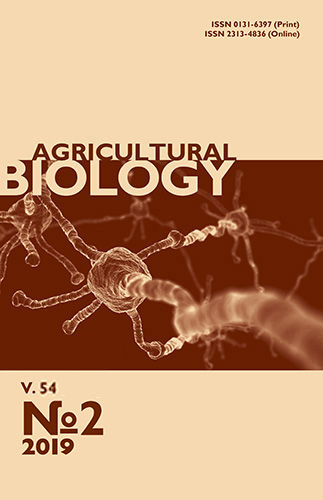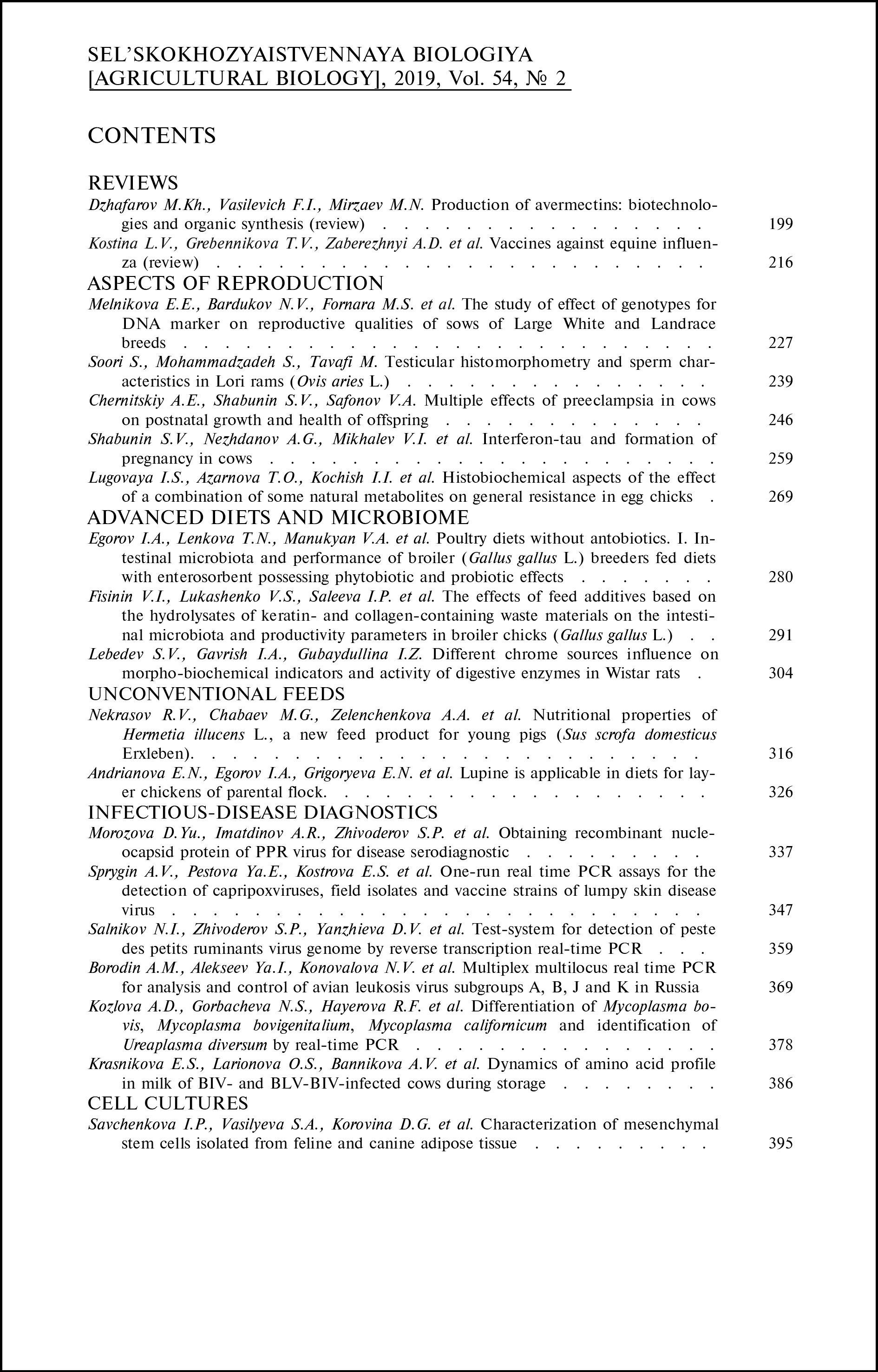doi: 10.15389/agrobiology.2019.2.359eng
UDC: 619:578:616.5:57.083.2:577.2
Acknowledgements:
Supported financially by grant of the President of the Russian Federation No. МК-2090.2018.11 for state support of young Russian scientists.
TEST-SYSTEM FOR DETECTION OF PESTE DES PETITS RUMINANTS VIRUS GENOME BY REVERSE TRANSCRIPTION REAL-TIME PCR
N.I. Salnikov, S.P. Zhivoderov, D.V. Yanzhieva, A.Yu. Koltsov,
T.R. Usadov, M.M. Suher, Yu.P. Morgunov, A.V. Lunitsyn
Federal Research Center for Virology and Microbiology, 1, ul. Akademika Bakuleva, pos. Vol’ginskii, Petushinskii Region, Vladimir Province, 601125 Russia, e-mail nikolai.salnikov2010@yandex.ru (corresponding author ✉), zhivoderov-serg@mail.ru, darima.yanzhieva.90@mail.ru, kolcov.andrew@gmail.com, usadov.tr@mail.ru, suhermail@mail.ru, morgunovvv@mail.ru, lunicyn@mail.ru
ORCID:
Salnikov N.I. orcid.org/0000-0002-0481-3872
Usadov T.R. orcid.org/0000-0003-3102-1931
Zhivoderov S.P. orcid.org/0000-0002-4919-3080
Sukher M.M. orcid.org/0000-0002-1335-310X
Yanzhieva D.V. orcid.org/0000-0001-7390-3874
Morgunov Yu.P. orcid.org/0000-0003-4980-8302
Koltsov A.Yu. orcid.org/0000-0003-3294-6602
Lunitsyn A.V. orcid.org/0000-0002-5043-446X
Received November 27, 2018
Peste des petits ruminants (PPR) is a highly contagious transboundary infection disease of small ruminants, characterized by fever, anorexia, ocular and nasal discharge, erosions and ulcers in digestive mucosa, diarrhoea and marked leucopoenia with immunosuppression. Because of the complexity of the PPR epizootic situation in neighboring countries (Tajikistan, China, Mongolia, Kazakhstan, Afghanistan) the risk of occurrence of this disease on the territories of Siberian, Ural, Far Eastern, North Caucasian and Southern Federal Districts of Russian Federation is very high. So, the development of molecular-genetic methods for the diagnosis of PPR and methods for stabilizing of biological samples represents scientific relevance. This article presents data on the development of a test system for detecting the PPR virus genome by reverse transcription Real-Time PCR. This technique is based on the amplification of a fragment (148 bp) of hemagglutinin gene of PPR virus using the original oligonucleotide primers and fluorescent-labeled hybridization probe. Analytical specificity of the developed test system was evaluated by testing the strains of PPR virus, rinderpest virus, bluetongue virus, as well as biological samples from clinically healthy animals and intact cell cultures. Positive results were obtained only with samples containing PPR virus (strains Epizootichesky, Nigeria 75/1 and 45G37/35-K). The analytical sensitivity of the developed test-system, determined using tenfold serial dilutions of cultural virus-containing material, is 0.83±0.22 lg TCID50/ml. To create a positive amplification control, a fragment of hemagglutinin gene synthesized usign Real-Time PCR was cloned in plasmid pTZ57 R/T in Escherichia coli. It was established that the plasmid DNA concentration for amplification linearity ranges from 2.4×107 to 24 molecules/μl. To assess the practical suitability of the developed test system for the diagnosis of PPR, the blood samples from sheep experimentally infected with PPR virus (strain Epizootichesky) were tested. As a result, the PPR virus genome was detected in blood samples from day 5 to day 12 after infection. Since transportation of biological samples over long distances may require during survey, we have developed “dry” blood method to collect and store blood samples. It has been shown that “dry” blood drops are stable at room temperature for a month and can be used in Real-Time PCR testing.
Keywords: peste des petits ruminants, virus, reverse transcription, PCR, cell culture, recombinant plasmid, experimental infection.
REFERENCES
- Zakutskii N.I. Nauchnyi zhurnal KubGAU, 2012, 83: 10-24 (in Russ.).
- Syurin V.N., Samuilenko A.Ya., Solov'ev B.V., Fomina N.V. Virusnye bolezni zhivotnykh [Viral diseases of animals]. Moscow, 1998 (in Russ.).
- Kumar N., Maherchandani S., Kashyap S.K., Singh S.V., Sharma S., Chaubey K.K., Ly H. Peste des petits ruminants virus infection of small ruminants: a comprehensive review. Viruses, 2014, 6: 2287-2327 CrossRef
- Khan A., Saleemi M.K., Ali F., Abubakar M., Hussain R., Abbas R.Z., Khan I.A. Pathophysiology of peste des petits ruminants in sheep (Dorper & Kajli) and goats (Boer & Beetal). Microbial Pathogenesis,2018, 117: 139-147 CrossRef
- Wohlsein P., Saliki J. Rinderpest and peste des petits ruminants virus: plague of large and small ruminants — the diseases: clinical sciences and pathology. In: Rinderpest and peste des petits ruminants virus: plague of large and small ruminants. T. Barrett, P.P. Pastoret, W.P. Taylor (eds.).Academic Press, London, UK, 2006: 68-83.
- Baron M.D., Diallo A., Lancelot R., Libeau G. Peste des petits ruminants virus. Adv. Virus Res., 2016, 95: 1-42 CrossRef
- Dundon W.G., Adombi C.M., Kanu S., Loitsch A., Cattoli G., Diallo A. Complete genome sequence of a lineage II peste des petits ruminants virus from Sierra Leone. Genome Announc., 2018, 6(1): e01417-17 CrossRef
- Gibbs E.P., Taylor W.P., Lawman, M.J., Bryant, J. Classification of peste des petits ruminants virus as the fourth member of the genus morbillivirus. Intervirology, 1979, 11: 268-274.
- Samal S.K. Paramyxoviruses of animals. In: Encyclopedia of virology /B.W.J. Mahy, M.H.V. Van Regenmortel (eds.). San Diego, United States, Elsevier Science Publishing Co Inc., 2008: 40-47 CrossRef
- Kwiatek O., Ali Y.H., Saeed I.K., Khalafalla A.I., Mohamed O.I., Obeida A.A., Abdelrahman M.B., Osman H.M., Taha K.M., Abbas Z., El Harrak M., Lhor Y., Diallo A., Lancelot R., Albina E., Libeau G. Asian lineage of peste des petits ruminants virus, Africa. Emerging Infectious Diseases, 2011, 17: 1223-1231 CrossRef
- Dhar P, Sreenivasa B.P., Barrett T., Corteyn M., Singh R.P., Bandyopadhyay S.K. Recent epidemiology of peste des petits ruminants virus (PPRV). Veterinary Microbiology, 2002, 88: 153-159 CrossRef
- Muniraju M., Munir M., Parthiban A.B.R., Banyard A.C., Bao J., Wang Z., Ayebazibwe C., Ayelet G., Harrak M.E., Mahapatra M., Libeau G., Batten C., Parida S. Molecular evolution of peste des petits ruminants virus. Emerging Infectious Diseases, 2014, 20: 2023-2033 CrossRef
- Parilov S.V., Knize A.V., Balyshev V.M. Nauchnyi zhurnal KubGAU, 2011, 69: 423-432 (in Russ.).
- Shcherbinin C.V., Karaulov A.K., Zakharov V.M. Veterinariya segodnya, 2017, 4: 17-22 (in Russ.).
- Office International des Epizooties (OIE). Manual of diagnostic tests and vaccines for terrestrial animals 2017. Chapter 2.07.10. Peste des petits ruminants (infection with peste des petits ruminants virus). Available http://www.oie.int/fileadmin/Home/eng/. No date.
- Couacy-Hymann E., Bodjo S.C., Koffi M.Y., Kouakou C., Danho T. The early detection of peste-des-petits-ruminants (PPR) virus antigens and nucleic acid from experimentally infected goats using RT-PCR and immunocapture ELISA techniques. Research in Veterinary Science, 2009, 87: 332-335 CrossRef
- Shaila M.S., Shamaki D., Forsyth M.A., Diallo A., Goatley L., Kitching R.P., Barrett T. Geographic distribution and epidemiology of Peste des Petits Ruminants viruses. Virus Research, 1996, 43: 149-153.
- Bao J., Li L., Wang Z., Barrett T., Suo L., Zhao W., Liu Y., Liu C., Li J. Development of one-step real-time RT-PCR assay for detection and quantitation of Peste des Petits Ruminants virus. Journal of Virological Methods, 2008, 148: 232-236 CrossRef
- Kwiatek O., Keita D., Gil P., Fernandez-Pinero J., Clavero M.A., Albina E., Libeau G. Quantitative one-step real-time RT-PCR for the fast detection of the four genotypes of PPRV. Journal of Virological Methods, 2010, 165: 168-177 CrossRef
- Batten C.A., Banyard A.C., King D.P., Henstock M.R., Edwards L., Sanders A., Buczkowski H., Oura C.C.L., Barrett T. A real time RT-PCR assay for the specific detection of Peste des petits ruminants virus. Journal of Virological Methods, 2011, 171: 401-404 CrossRef
- Balamurugan V., Sen A., Venkatesan G., Yadav V., Bhanot V., Bhanuprakash V., Singh R.K. Application of semi-quantitative M gene-based hydrolysis probe (TaqMan) real-time RT-PCR assay for the detection of Peste des petitis ruminants virus in the clinical samples for investigation into clinical prevalence of disease. Transboundary and Emerging Diseases, 2010, 57: 383-395 CrossRef
- Berg Sh., Bøtner A., Browman H., De Koeijer A., Depner K., Domingo M., Ducrot Ch., Edwards S., Fourichon Ch., Koenen F., More S., Raj M., Sihvonen L., Spoolder H., Stege-man J.A., Thulke H.H., Vågsholm I., Velarde A., Willeberg P., Zientara S. Scientific opinion on peste des petits ruminants. EFSA AHAW Panel (EFSA Panel on Animal Health and Welfare). EFSA Journal, 2015, 13(1): 3985 CrossRef
- Bhuiyan A.R., Chowdhury E.H., Kwiatek O., Parvin R., Rahman M.M., Islam M.R., Albina E., Libeau G. Dried fluid spots for peste des petits ruminants virus load evaluation allowing for non-invasive diagnosis and genotyping. BMC Vet. Res., 2014, 10: 247 CrossRef
- Bolais P.F., Vignoles P., Pereira P.F., Keim R., Aroussi A., Ismail K., Dardé M.L., Amendoeira M.R., Mercier A. Toxoplasma gondii survey in cats from two environments of the city of Rio de Janeiro, Brazil by Modified Agglutination Test on sera and filter-paper. Parasite Vectors, 2017, 10: 88 CrossRef
- Truong T., Boshra H., Embury-Hyatt C., Nfon C., Gerdts V., Tikoo S., Babiuk L.A., Kara P., Chetty T., Mather A. Peste des petits ruminants virus tissue tropism and pathogenesis in sheep and goats following experimental infection. PLoS ONE, 2014, 9: e87145 CrossRef
- Couacy-Hymann E., Bodjo C., Danho T., Libeau G., Diallo A. Evaluation of the virulence of some strains of peste-des-petits-ruminants virus (PPRV) in experimentally infected West African dwarf goats. The Veterinary Journal, 2007, 173: 178-183 CrossRef
- Harrak M.E., Touil N., Loutfi C., Hammouchi M., Parida S., Sebbar G., Chaffai N., Harif B., Messoudi N., Batten C., Oura C.A.L. A reliable and reproducible experimental challenge model for peste des petits ruminants virus. Journal of Clinical Microbiology, 2012, 50: 3738-3740 CrossRef












